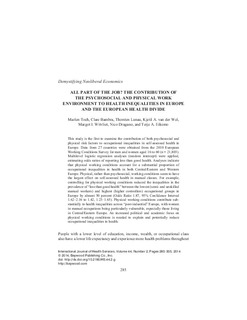| dc.contributor.author | Toch-Marquardt, Marlen | |
| dc.contributor.author | Bambra, Clare | |
| dc.contributor.author | Lunau, Thorsten | |
| dc.contributor.author | van Der Wel, Kjetil A. | |
| dc.contributor.author | Witvliet, Margot I. | |
| dc.contributor.author | Dragano, Nico | |
| dc.contributor.author | Eikemo, Terje Andreas | |
| dc.date.accessioned | 2015-02-03T06:45:11Z | |
| dc.date.accessioned | 2016-04-21T11:20:50Z | |
| dc.date.available | 2015-02-03T06:45:11Z | |
| dc.date.available | 2016-04-21T11:20:50Z | |
| dc.date.issued | 2014 | |
| dc.identifier.citation | International Journal of Health Services 2014, 44(2):285-305 | nb_NO |
| dc.identifier.issn | 1541-4469 | |
| dc.identifier.uri | http://hdl.handle.net/11250/2386752 | |
| dc.description.abstract | This study is the first to examine the contribution of both psychosocial and physical risk factors to occupational inequalities in self-assessed health in Europe. Data from 27 countries were obtained from the 2010 European Working Conditions Survey for men and women aged 16 to 60 (n = 21,803). Multilevel logistic regression analyses (random intercept) were applied, estimating odds ratios of reporting less than good health. Analyses indicate that physical working conditions account for a substantial proportion of occupational inequalities in health in both Central/Eastern and Western Europe. Physical, rather than psychosocial, working conditions seem to have the largest effect on self-assessed health in manual classes. For example, controlling for physical working conditions reduced the inequalities in the prevalence of "less than good health" between the lowest (semi- and unskilled manual workers) and highest (higher controllers) occupational groups in Europe by almost 50 percent (Odds Ratio 1.87, 95% Confidence Interval 1.62-2.16 to 1.42, 1.23-1.65). Physical working conditions contribute substantially to health inequalities across "post-industrial" Europe, with women in manual occupations being particularly vulnerable, especially those living in Central/Eastern Europe. An increased political and academic focus on physical working conditions is needed to explain and potentially reduce occupational inequalities in health. | nb_NO |
| dc.language.iso | eng | nb_NO |
| dc.publisher | SAGE Publications | nb_NO |
| dc.title | All Part of the Job? The contribution of the Psychosocial and Physical Work Environment to Health Inequalities in Europe and the European Health Divide | nb_NO |
| dc.type | Journal article | nb_NO |
| dc.type | Peer reviewed | nb_NO |
| dc.date.updated | 2015-02-03T06:45:11Z | |
| dc.source.volume | 44 | nb_NO |
| dc.source.journal | International Journal of Health Services | nb_NO |
| dc.source.issue | 2 | nb_NO |
| dc.identifier.doi | 10.2190/HS.44.2.g | |
| dc.identifier.cristin | 1132236 | |
| dc.relation.project | Norges forskningsråd: 217145 | nb_NO |
| dc.description.localcode | © 2014, Baywood Publishing Co., Inc. Open Access article. | nb_NO |
